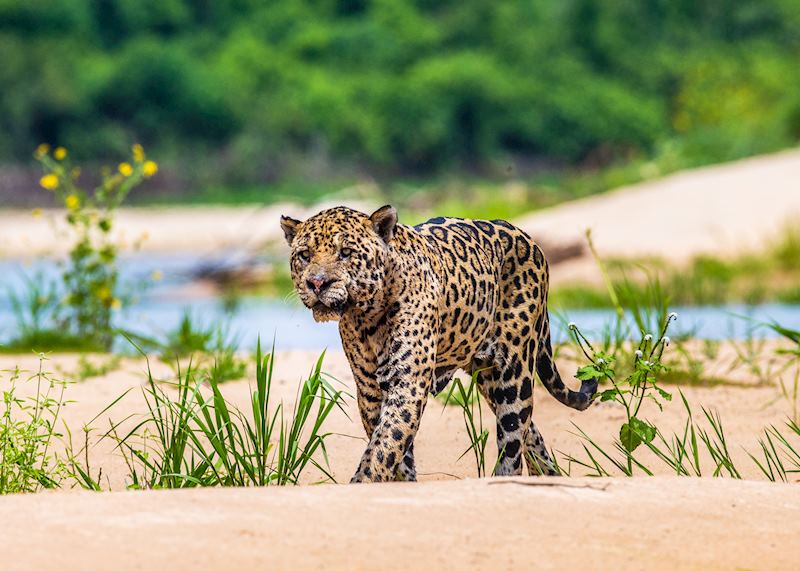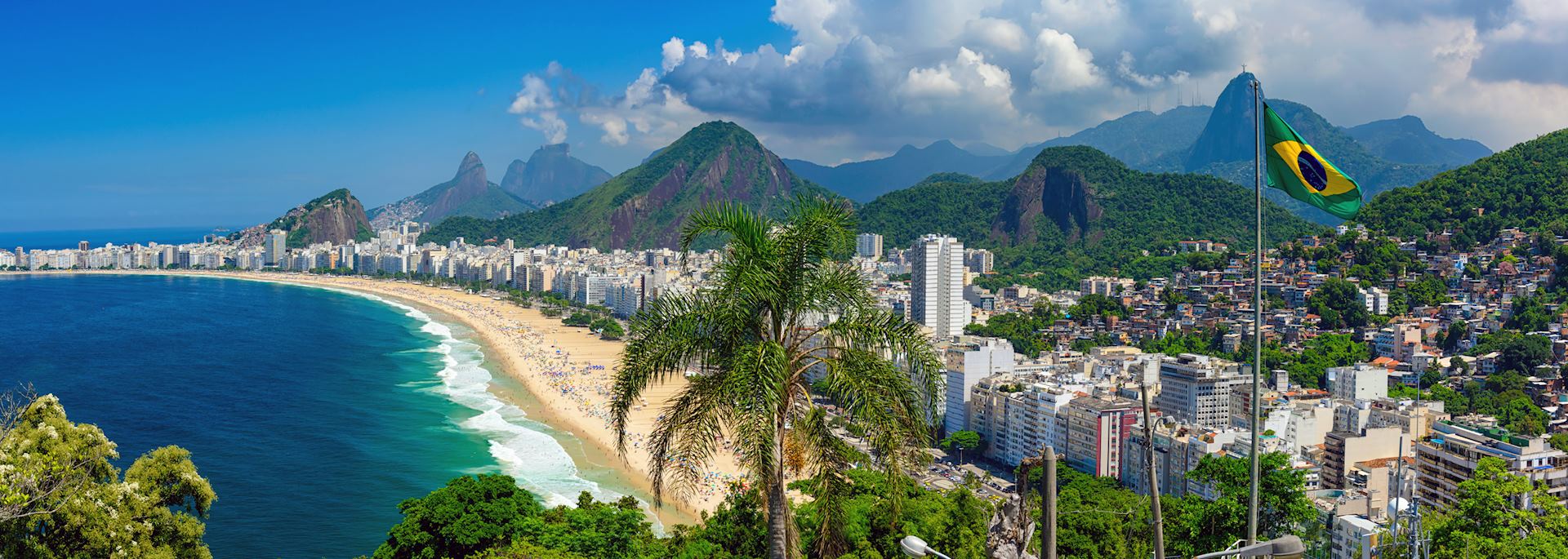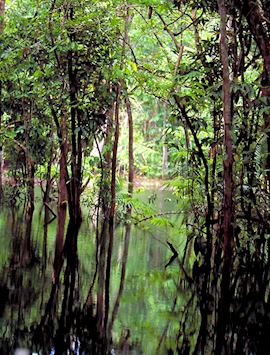Although famous for the Amazon, its beaches, football and samba, there is in fact a great deal more to Brazil.
Cities such as Rio, Salvador and Brasília boast striking architecture, the Pantanal has some of the best wildlife spotting opportunities in Latin America and there are endless walking options in some of its less well known national parks.
Read the chapters below to find out more about the best of Brazil and the places that should be included in any first trip to this country.
Rio de Janeiro
Rio de Janeiro is Brazil’s and perhaps Latin America’s most well known city. It spills out from the Atlantic Ocean, rises up from its famous white beaches of Copacabana and Ipanema and spreads into tree-lined streets of white apartment buildings that skirt shady parks and plazas.
It is a city that should not be missed by any visitor to Brazil, whether it’s a first trip or the tenth. It’s a place of contrasts; a buzzing, modern metropolis yet home to the world’s largest urban forest. Rio epitomises the country in every way. It is culturally rich, full of music and dance and its beaches, and the Brazilians who strut purposefully along them, are among the most beautiful in the Americas.
The iconic statue of Christ the Redeemer embraces Rio in its outstretched arms. Look up from any point in the city and the chances are you will catch him looking down on you. Take the cog railway to the top of Corcovado to see it close up, and when the clouds lift, the views it offers over the city to the sea beyond are second to none.
A trip on the cable car to the top of Sugarloaf Mountain to watch the sunset over Botafogo Bay and the twinkling city beyond is a truly unforgettable experience; do it late in the afternoon as the sun sets over the city.

Iguaçu Falls
Legend has it that when Eleanor Roosevelt first visited Iguaçu Falls, she exclaimed, ‘poor Niagara’. Standing looking at these magnificent falls, hearing the roar of the water and feeling the spray on your face, it’s quite easy to understand her sentiments.
Iguaçu Falls, surrounded by lush green national parks, sit on the border of Brazil and Argentina and are made up of 275 individual falls, stretching 3 km (2 miles) in width and crashing down over 80 m (262 ft). The Brazilian side of the falls boasts breathtaking panoramic views.
Step out of the Hotel das Cataratas and you come face-to-face with a vast stretch of tumbling water, the spray from which rises up to a mile into the air. Cross the border to the Argentine side and take the opportunity to stroll the jungle clad walkways that weave in and out of the many smaller falls. Finally, ride the little railway to the aptly named ‘Garganta del Diablo’ or Devil’s Throat where thousands of litres of water will rush under your feet as they continue their hurried journey down the Iguaçu river.
Salvador
Originally settled by the Portuguese in the 16th century, Brazil’s first capital city, Salvador, exudes energy from every pore, and no visitor will fail to become intoxicated by its architecture, colours, music and flavours. Pelourinho, the historic centre of the city, is without doubt a mecca for the Brazilian and international visitor but that doesn’t diminish the charm of its beautiful pastel coloured colonial buildings, its ornate 17th and 18th century churches and the warmth of its people.
Around every turn is a fresh delight; a baroque style church, an art museum, a café or bar spilling tables and chairs onto the cobbled street or a group of drummers beating out the complicated rhythms of samba. The heritage of the African slaves, trafficked over by the colonial power, is evident at every turn from the trance-like figures, dressed in white during a Candomblé ceremony to ‘moqueca’, the spicy fish stew flavoured with African spices, and the acrobatic capoeira dancers, spinning to the beat of the one stringed berimbau.
Salvador also boasts long stretches of beach and is a great starting point for a few days’ exploration of the Bahian hinterland with its miles of sugar cane plantations, sleepy riverside villages, mountains and caves.

The Amazon
The word alone conjures images of vast roaring rivers, feisty tribal women, impenetrable jungle and tropical wildlife.
The Brazilian Amazon offers a comprehensive introduction to the jungle experience. Lodges and boats based around the tropical port city of Manaus offer excursions along the river and its tributaries, largely in motorised canoes. Night excursions with local guides along jungle trails surrounded by the buzz of cicadas and the distant screech of monkeys reveal huge spiders, waiting by their lairs for unsuspecting prey, and, as you approach the water, the bright red eyes of the many caiman that inhabit the area.
The wildlife of Brazil’s Amazon however is not as easily accessible to the visitor as that of other parts of the South American Amazon. Being relatively close to Manaus, much of the fauna around the area’s lodges has disappeared deeper into the rainforest to hide in its dense vegetation. A visit to this part of Brazil, whilst offering the chance to experience a taste of the authentic tropical rainforest that engulfs one of the world’s mightiest rivers, should not be undertaken with the sole purpose of observing the area’s wildlife.
For those with a general interest in all things tropical however, the accessibility of Brazil’s Amazon makes it just the place.

The Pantanal
Without doubt the best place for wildlife in Brazil is the vast area of wetlands bordering Bolivia and Paraguay in the west of the country. The Pantanal stretches for 109,435 sq km (42,253 sq miles), spread across the states of Mato Grosso and Mato Grosso do Sul. It is sparsely populated by humans but rich with birdlife and mammals.
Lodges in the Pantanal tend to be relatively simple and sometimes family run. They make an excellent base from which to get to know the local flora and fauna. Guides will accompany you on horseback, in kayaks, motorised canoes, open-top jeeps and on foot to explore the area and giving you the opportunity to enjoy sightings of capybara, caiman, howler monkeys, anteaters, deer, porcupines, giant otters and jaguars if you’re lucky. In addition you’ll see macaws, storks, hawks, herons, ibis and rhea.
The best time to visit the Pantanal is between May to October, with the best birding opportunities between July and September and the best jaguar sightings in September and October. The rest of the year is very wet and can be very humid but shouldn’t be written off for visits. Access to the Pantanal is through the two nearest cities, Campo Grande and Cuiabá, both of which are easily accessible by air from Rio or São Paulo.

Beaches
One of the many things Brazil has in abundance is beaches. The country’s coastline stretches for over 7,242 km (4,499 miles) from its border with French Guyana to Uruguay in the south. There are city beaches such as Copacabana and Ipanema in Rio, beaches to watch whales from, beaches backed by jungle, beaches from which to windsurf and simply miles and miles of deserted palm fringed beaches.
Many of the country’s most famous beaches stretch along the coast of Bahia. We love the area around Trancoso, a charming village with a beautiful main square and numerous lovely pousadas. Beaches in this area are almost empty for much of the year, making it a great spot for a romantic retreat.
Further north at the village of Jericoacoara the waves are perfect for windsurfing and you can even try your hand at kitesurfing whilst looking out to the Atlantic or inland to the area’s huge sand dunes.
The Green Coast between Rio and São Paulo is full of tiny sandy coves watched over by Atlantic rainforest. Schooner trips around the islands in this area make for a lovely day trip.
Given Brazil’s size and diversity, you should be prepared for an inevitable amount of flying but this also means that we can suggest ideas and itineraries to suit most tastes, interests and budgets.

Read more about trips to Brazil
Start thinking about your experience. These itineraries are simply suggestions for how you could enjoy some of the same experiences as our specialists. They're just for inspiration, because your trip will be created around your particular tastes.
View All Tours in Brazil




